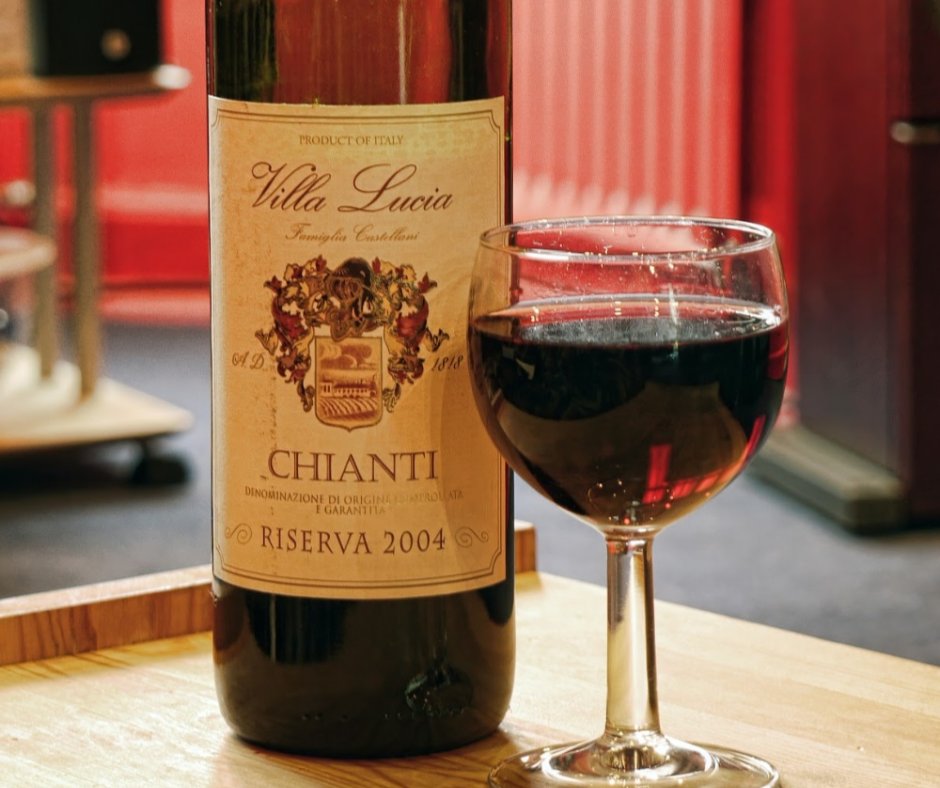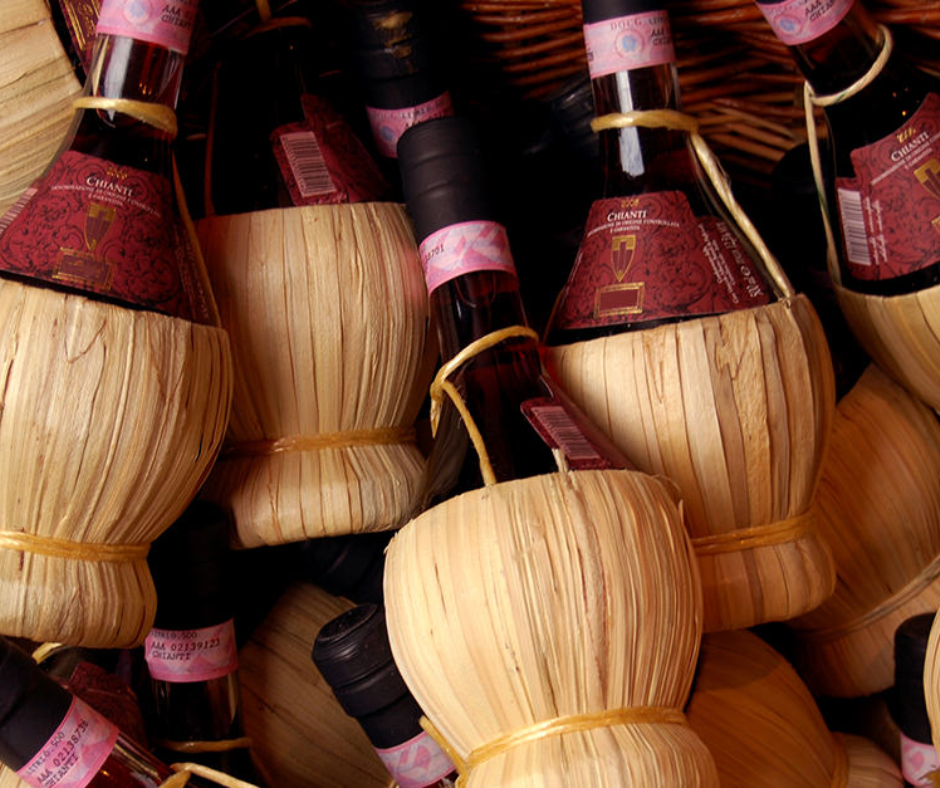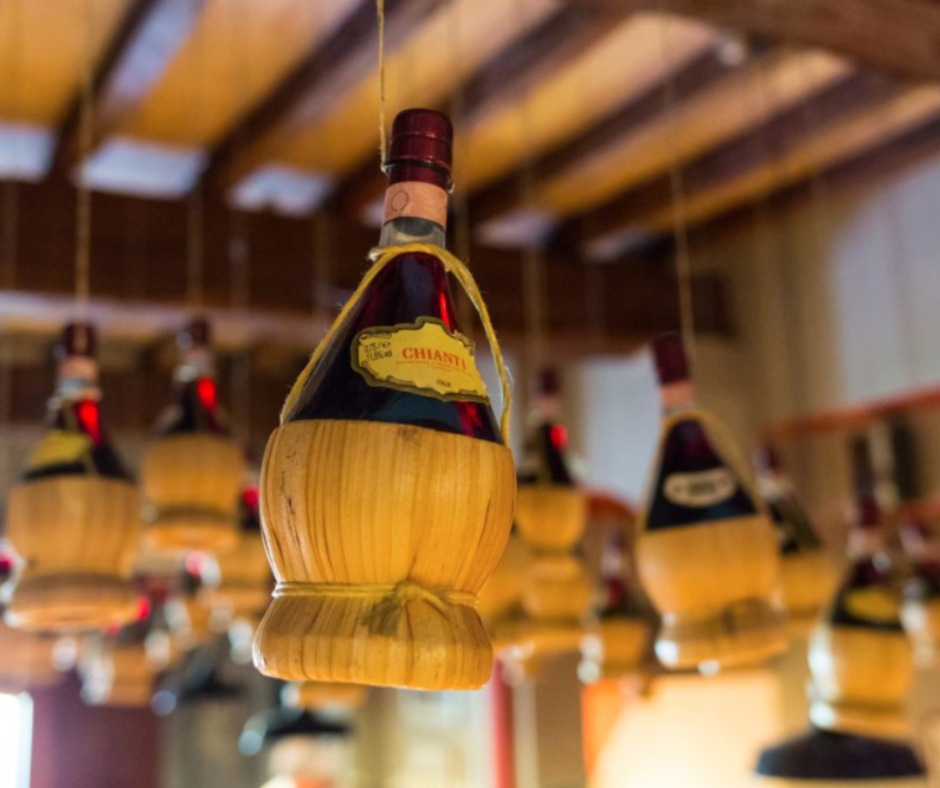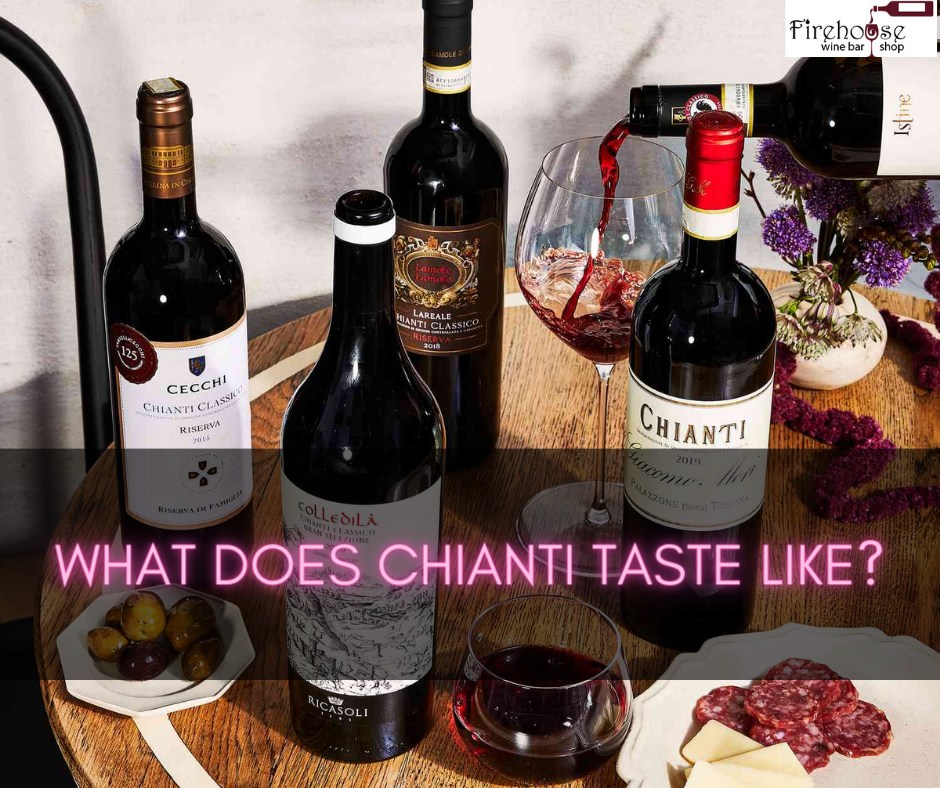Introduction
Chianti wine is significant in Italian cuisine, often paired with traditional dishes like prosciutto and pasta al pomodoro. Its distinctive flavor profile and versatility make it a popular choice for wine enthusiasts and food lovers. This blog section will explore ‘What Does Chianti Taste Like?‘, shedding light on why it has become such a beloved Italian classic.

The Significance Of Chianti Wine In Italian Cuisine
Chianti wine, also known as “kee-on-tee,” is a red blend made primarily with Sangiovese grapes from the Tuscany region of Italy. It features common tasting notes of red fruits, dried herbs, balsamic vinegar, smoke, and game. However, the flavor profile of Chianti wine can vary depending on the specific region and winemaking techniques employed.
Italian cuisine embraces the tart, spicy, and herbaceous qualities of Chianti wine and often pairs it with dishes that highlight its flavors. Chianti’s high acidity and coarse tannins make it an excellent complement to rich, fatty dishes and tomato-based pasta sauces. Its savory flavors and vibrant acidity enliven the palate, making it an ideal wine for enjoying with various foods.
The Flavor Profile Of Chianti Wine: An Overview
Chianti wine offers a visceral tasting experience, evoking the essence of Italy itself. Imagine walking through an Italian grocery store with scents of preserved sour Amarena cherries, dried oregano, dark aromatic balsamic vinegar, and dry salami wafting through the air. Chianti wine captures these intoxicating aromas and delivers them to the palate.
Sangiovese, the main grape used in Chianti, lends the wine its signature characteristics. A glass of Chianti displays a ruby red color with flashes of bright burnt orange, reminiscent of aged wines. The slight coarseness and tartness on the palate are not flaws but classic traits of Sangiovese.
The flavor profile of Chianti wine can evolve as it ages. As Sangiovese matures, it becomes savory, loses color, and softens its tannins. While only the best wines can age over a long period, younger Chianti wines that spend up to six months in oak barrels offer a young, simple, tart, fresh taste.
Aged Chianti wines, aged for at least two years, exhibit bolder characteristics, often with oak aromas such as vanilla or spice. The most sought-after wines in Tuscany are aged for over 2.5 years and showcase intense tannins, flavors, and aromas, ranging from dried cherry, smoke, and balsamic to leather.
Here’s a table summarizing the flavor profile and aging classifications of Chianti wine:
| Age Classification | Tasting Notes |
|---|---|
| Aged for six months | Young, simple, tart, and fresh |
| Aged for a year | Slightly bolder wines with smoother tannins |
| Aged for two years | Top wines with oak aromas like vanilla or spice |
| Aged for 2.5 years or more (Chianti Classico) | Intense tannins, flavors, and aromas of dried cherry, smoke, balsamic, and leather |
These flavor profiles and aging classifications offer wine enthusiasts a range of options to explore and enjoy, each with unique charm.
In conclusion, Chianti wine is a treasure of Italian cuisine, appreciated for its distinct flavor profile. Its taste of dark cherries, dried herbs, balsamic vinegar, and tobacco, coupled with its vibrant acidity and coarse tannins, make it a versatile wine that pairs perfectly with various dishes. Whether savoring a traditional Tuscan pasta or indulging in a juicy steak, Chianti wine adds a classic touch of Italy to any meal.
What Does Chianti Taste Like?

So, What Does Chianti Taste Like? When it comes to tasting Chianti wine, several distinctive flavor profiles make it a beloved choice among wine enthusiasts. From its fruity and juicy notes to its complex and evolving character, Chianti offers a unique taste experience that captures the essence of Italy’s renowned wine region, Tuscany. Let’s explore the primary, secondary, and tertiary tasting notes that define the flavor profile of Chianti wine.
Primary Tasting Notes: Fruitiness And Juiciness
One of the defining characteristics of Chianti wine is its vibrant fruitiness. When you sip Chianti, you can expect to taste delicious dark cherries, ripe plums, and juicy raspberries. These primary flavors give Chianti its luscious and succulent quality, creating a delightful sensory experience on the palate. The sun-drenched slopes of the Chianti region infuse the grapes with intense flavors that truly capture the essence of the Tuscan landscape.
Secondary Tasting Notes: Oak And Aging Characteristics
As Chianti wines age, they develop secondary tasting notes that add depth and complexity to their flavor profile. Oak and aging characteristics play a significant role in shaping these secondary notes. Some Chianti wines may display subtle hints of vanilla, spice, or smoke, imparted by the oak barrels in which they are aged. These flavors complement the fruity primary notes and contribute to the overall balance and richness of the wine.
Tertiary Tasting Notes: Complexity And Development
With further aging, Chianti wines develop tertiary tasting notes that showcase their complexity and maturity. These notes evolve, offering a fascinating tasting experience. You may encounter flavors such as dried cherry, balsamic reduction, and leather in well-aged Chianti wines. These tertiary notes add layers of depth and nuance to the wine, reflecting its unique journey from vine to bottle.
Here’s a table summarizing the tasting notes of Chianti wine:
| Tasting Notes | Primary | Secondary | Tertiary |
|---|---|---|---|
| Flavors | Dark cherries, plums, raspberries | Hints of vanilla, spice, smoke | Dried cherry, balsamic reduction, leather |
| Characteristics | Fruity, juicy | Balanced, rich | Complex, mature |
It’s important to note that while Chianti wines share common tasting notes, each bottle can uniquely express these flavors. Factors such as the specific vineyard, winemaking techniques, and aging process contribute to the individual character of each Chianti wine.
In conclusion, the taste of Chianti wine is defined by its fruity and juicy nature, accompanied by secondary notes of oak and aging characteristics. As the wine ages, it evolves to showcase tertiary notes that bring complexity and development. Combining these tasting notes creates a sensory experience that captures the essence of the Chianti region’s sun-drenched slopes and rich winemaking tradition.
Factors Affecting The Taste Of Chianti Wine
When describing ‘What Does Chianti Taste Like?’, several factors contribute to its unique taste. From the influence of terroir to the winemaking techniques used, each aspect plays a role in shaping the characteristics of this renowned Italian wine.
Terroir: The Influence Of Soil, Climate, And Elevation
The concept of terroir refers to the combined effects of soil, climate, and elevation on the growth and development of grapevines. In the case of Chianti wine, these factors significantly impact the final product’s taste.
The soil in the Chianti region is rich and fertile, providing the vineyards with abundant nutrients. This allows the grapes to absorb key elements, contributing to the complex fruity and earthy notes in Chianti wine. The specific soil composition, which includes varieties such as Galestro marl and Alberese sandstone, plays a crucial role in producing the bold flavors that characterize Chianti wines.
The climate of the Chianti region also influences the taste of the wine. The warm climate of the Chianti Classico region, located in the hills above Florence, promotes the development of ripe and flavorful grapes. This results in wines with intense tannins, flavors, and aromas, ranging from dried cherry to smoked, balsamic, and leather. The combination of warm days and cool nights in this area further enhances the complexity and balance of Chianti wines.
Elevation is another factor that contributes to the taste of Chianti wine. Higher elevations within the region, such as those found in the original boundaries of Chianti, produce wines of smaller quantities but of higher quality. These elevated vineyards benefit from better air circulation and cooler temperatures, which can improve grape ripening and preserve the natural acidity of the wine. As a result, Chianti wines from higher elevations often exhibit greater finesse and age-ability.
Winemaking Techniques: Fermentation, Maturation, And Aging
The winemaking techniques employed during the production of Chianti wine also play a significant role in its flavor profile. The primary grape in Chianti is Sangiovese, a thin-skinned variety known for its pale-colored wines. However, Chianti wines may contain other grape varieties like Canaiolo and Colorino, although white grapes are no longer allowed in Chianti Classico.
Fermentation, maturation, and aging further shape the taste of Chianti wine. Depending on the specific classification of the wine, different aging requirements apply. Younger Chianti wines, aged for around six months, tend to be simple, tart, and fresh. Wines aged for a year offer slightly bolder flavors with smoother tannins. Those aged for two years, usually the top wines from a producer, may exhibit oak aromas such as vanilla or spice. Chianti Classico wines aged for at least 2.5 years, labeled Riserva or Gran Selezione, offer intense tannins, flavors, and aromas that continue to develop over time.
Ultimately, the flavor profile of Chianti wine can be described as a combination of red fruits such as cherries and strawberries, dried herbs, balsamic vinegar, smoke, and game. High acidity and coarse tannins make Chianti an excellent wine for pairing with a wide range of foods, including tomato-based pasta sauces, pizza, and grilled meats.
In conclusion, the distinct taste of Chianti wine is shaped by the interaction of various factors. From the unique characteristics of the terroir to the careful application of winemaking techniques, each element contributes to this beloved Italian wine’s complex and iconic flavor profile.
Pairing Chianti Wine With Food

Chianti wine, hailing from the world-famous vineyards of Tuscany, boasts a distinct flavor profile that perfectly accompanies a wide array of dishes. Known for its dry, medium-bodied red wine, Chianti offers a complex and varied taste that captures the essence of the Italian countryside.
Why Chianti Wine Is Perfect For Food Pairing?
Chianti’s flavor profile makes it an ideal wine for pairing with food. Its high tannin level contributes to its dry flavor, while its floral scent and deeply savory notes enhance the overall taste. Combining these elements creates a wine that complements a range of flavors and textures, making it a versatile choice for food pairing.
Classic Food Pairings For Chianti Wine
Chianti wine pairs exceptionally well with Italian cuisine, particularly dishes that feature tomato sauce, grilled meats, and hearty, earthy flavors. Here are some classic food pairings that showcase the best of Chianti wine:
- Tomato sauce pasta dishes: The high acidity of Chianti wine stands up to the natural acidity of tomato-based pasta sauces, creating a harmonious balance of flavors. Whether it’s a classic spaghetti Bolognese or a rich lasagna, Chianti complements these dishes perfectly.
- Pizza: Chianti’s bold flavors and moderate acidity make it an excellent choice for pairing with pizza. Whether it’s a simple Margherita or a loaded meat lover’s pie, Chianti enhances the savory and robust flavors of the pizza.
- Steaks: The flavorful and juicy nature of Chianti wine pairs beautifully with grilled steaks. The wine’s high acidity cuts through the meat’s richness, while its savory notes complement the charred flavors.
- Slow-roasted pork: Chianti’s fruity and earthy notes are a delightful match for slow-roasted pork dishes. The wine’s bold flavors and moderate tannins elevate the succulent flavors of the meat.
- Salami: Chianti’s savory and spicy characteristics make it an ideal companion for cured meats like salami. The wine’s acidity helps cut through the richness of the salami, creating a balanced and enjoyable pairing.
- Game, especially wild boar: Chianti’s complexity and depth of flavor make it an excellent choice for pairing with game meats such as wild boar. The wine’s earthy and savory notes enhance the flavors of the meat, creating a memorable dining experience.
- Roast lamb: Chianti’s medium-bodied nature and savory notes make it an exceptional match for roasted lamb. The wine’s acidity complements the meat’s richness, while its flavors enhance the dining experience.
- Pecorino cheese: Chianti’s fruity and earthy flavors pair wonderfully with the creamy and saltiness of Pecorino cheese. The wine’s acidity helps to cleanse the palate, ensuring a delightful balance of flavors.
Chianti’s versatility and distinctive flavor make it a go-to wine for various food pairings. Whether you’re enjoying it with pasta, pizza, or a succulent steak, Chianti wine enhances the dining experience with its complex and complementary flavors. Cheers to savoring the best of Italian cuisine with a glass of Chianti!
Tasting Chianti Wine At The Vineyard
When it comes to experiencing the true flavor profile of Chianti wine, there is no better place than at the vineyard itself. The picturesque landscape of the Chianti region in Tuscany offers the perfect environment to appreciate and savor this unique wine.
Chianti wine is made primarily with Sangiovese grapes, contributing to its fruity and juicy character. The flavors of Chianti can vary depending on the sub-region, soil type, climate, and elevation of the vineyard. These factors help to express the grape’s character in their special way, creating various levels of power, ripeness, and finesse in the wine.
Visiting a vineyard allows you to taste various Chianti wines and learn about what makes each producer’s wine special. Instead of just opening a bottle at home, visiting the vineyard allows you to experience a range of wines, from inexpensive to beautifully aged, all in their natural terrain. You can truly appreciate the craftsmanship and dedication of producing Chianti wine.
The Pleasure Of Tasting Chianti Wine In Its Natural Environment
To fully appreciate the flavor profile of Chianti wine, it’s important to consider factors such as how recently the bottle has been opened or if it has had a chance to breathe. For example, when tasting a recently opened bottle of Chianti, you may find that the primary fruit aromas are still developing and may be somewhat muted. However, the wine can reveal its true potential with little breathing time.
Allowing the wine to breathe can soften the mouth-gripping tannins and balance the wine’s ripe cherry and raspberry flavors. You may also notice the emergence of secondary and tertiary aromas, such as black pepper, bitter espresso, sweet spice, dried prune, fig, and hints of fresh herb. These complex aromas and flavors add depth and nuance to the Chianti wine-tasting experience.
The Effect Of Breathing And Aging On Chianti Wine
Chianti wine is known for its high acidity and coarse tannins, which make it an excellent choice for pairing with food. The acidity matches rich and fatty dishes, while the tannins soften the meat and bring out its succulent flavors. Tomato-based pasta sauces, such as the Tuscan slow-simmered Ragù al Chingiale made with wild boar, and pizza are particularly fantastic food pairings for Chianti wine.
In terms of aging and classifications, as Sangiovese (the main grape in Chianti) ages, it becomes more savory, loses color, and its tannins soften. Different labeling terms indicate the aging process of Chianti wines, ranging from young and fresh to aged for several years. The top wines from the Chianti Classico region are labeled Riserva or Gran Selezione, offering intense tannins, flavors, and aromas.
In conclusion, tasting Chianti wine at the vineyard provides a beautiful setting to appreciate this iconic Italian wine’s various flavors and expressions. Whether you’re enjoying a recently opened bottle or allowing it to breathe, the depth and complexity of Chianti’s flavor profile are best experienced in conjunction with food. So, indulge in the sensory pleasure of Chianti wine and immerse yourself in Italian life’s vibrant flavors and aromas.
FAQ: What Does Chianti Taste Like?
Q: What does Chianti taste like?
A: Chianti is a wine that tastes as rich and varied as the landscape itself. The sun-drenched slopes and gently rolling hills of the Chianti region allow the Sangiovese grape to flourish to its full potential. The taste of Chianti can vary depending on the sub-region within Chianti, as each area has its own unique soils, climates, and elevations that influence the grape’s character. This creates various levels of power, ripeness, and finesse in the wine.
Q: How would you describe the taste of Chianti?
A: Chianti is known for being a grape that creates fruity, juicy wines with strong cherry notes and high acidity. However, it is never that simple. There are many quality levels of Chianti, ranging from inexpensive to premium, each adding a different voice and personality to this unique wine.
Q: Where is the best place to appreciate and experience the various flavors of Chianti?
A: The vineyard is one of the best places to appreciate and experience Chianti’s various flavors and expressions. The vineyards in Chianti offer a picture-postcard-perfect setting, with breathtaking landscapes that provide a stunning environment to enjoy a glass of wine in its natural terrain. Visiting a vineyard allows you to taste various wines and learn about what makes each producer’s wine special. Instead of just opening a bottle at home or choosing one from your cellar, you can experience anything from an inexpensive wine to a beautifully aged vintage.
Q: How does the taste of Chianti change with different conditions?
A: The taste of Chianti can change depending on various factors. Consider whether the wine has just been opened or has had a chance to breathe and if you are having it with food or without. For example, allowing a freshly opened Chianti some time to breathe can bring out the true potential of the wine. The initial sip may have primary fruit aromas struggling to deliver, but after half an hour of breathing, the wine’s complexity can develop and express itself. Mouth-gripping tannins can soften, balanced acidity can complement the ripe cherry and raspberry flavors, and tertiary aromas such as black pepper, bitter espresso, sweet spice, dried prune, fig, and fresh herbs can flourish.
Q: What foods pair well with Chianti?
A: Chianti is a wine that pairs well with food, especially hearty and earthy meals filled with meat and tomato-based dishes. The high acidity of Chianti stands up to the natural acidity of tomatoes, while its coarse tannins soften the meat and bring out its succulent flavors. A classic pairing is the “Tagliere,” a wooden board piled high with mouth-watering Italian cheese, salami, and prosciutto. The salty meat and creamy cheese drizzled with sweet dried fruit conserve or honey help bring out Chianti’s rich and fruity flavors while also softening and balancing the wine.
Q: How would you summarize the experience of tasting Chianti?
A: The vineyards in Chianti offer a beautiful setting, and the food complements the wine perfectly. When you taste Chianti at a vineyard, all the flavors suddenly make sense as they resonate around you. Balsamic, oregano, coffee, pepper, and fresh cherry – all flavors integral to Italian life – can be found in a beautifully balanced and well-rounded glass of Chianti. The experience allows you to appreciate the diversity and complexity of this unique wine in its natural environment.
Conclusion
Now you should know the answer to ‘What Does Chianti Taste Like?’. Chianti wine, hailing from the beautiful region of Tuscany, Italy, offers a unique and captivating flavor profile that is beloved by wine enthusiasts worldwide. The taste of Chianti can be described as rich, varied, and deeply rooted in the Italian countryside. Let’s delve into the complexities and characteristics that make Chianti a truly special wine.
Chianti is primarily made with the Sangiovese grape, contributing to its distinct flavor profile. It is known for its fruity and juicy nature, with strong notes of cherries. The wine’s high acidity gives it a refreshing and zesty quality, making it a perfect companion for Italian cuisine.
To fully appreciate the flavor profile of Chianti, it’s important to consider the wine’s different levels and quality classifications. Chianti wines can range from affordable to premium selections, each offering a unique voice and personality.
The flavor profile of Chianti can vary depending on various factors, such as the sub-region where it is produced, the soil, climate, and elevation. These elements contribute to the wine’s power, ripeness, and finesse. Some Chianti wines may exhibit notes of dark cherries and plums, while others may showcase a bouquet of dried herbs and tobacco.
Let’s take a closer look at the typical characteristics and flavor profile of Chianti wine:
- Savory Flavors: Chianti wines are known for their savory flavors, which make them incredibly food-friendly. The wine’s high acidity cuts through richer, fatty dishes and stands up well to tomato-based sauces.
- High Acidity: Chianti wines have a noticeable acidity that adds freshness and vibrancy to the overall taste. The acidity also complements the natural acidity of tomatoes in pasta sauces and pairs well with olive oil dishes.
- Coarse Tannins: Chianti wines usually have firm and coarse tannins. These tannins provide structure and texture to the wine, creating a gripping sensation on the palate.
- Fruit Notes: As mentioned earlier, Chianti wines often exhibit vibrant cherry notes. The fruity nature of the wine adds to its overall appeal and makes it enjoyable to drink.
- Herbal and Earthy Undertones: Chianti wines can also have hints of dried herbs, such as oregano, and earthy flavors that reflect the region’s terroir. These nuances contribute to the wine’s complexity and depth.
Chianti wine is often best enjoyed with food, particularly hearty and earthy dishes. It pairs exceptionally well with Italian cuisine, such as sliced prosciutto, pasta al pomodoro, and Tuscan slow-simmered Ragù al Chingiale made with wild boar. The wine’s acidity stands up to the acidity of tomatoes, while the coarse tannins complement and soften the richness of meats.
To fully embrace the flavors of Chianti, visiting the vineyards in Tuscany can be an unforgettable experience. Tasting the wines in their natural terrain allows a deeper understanding of the different expressions and nuances that each producer brings to their wine.
In conclusion, Chianti wine offers a rich, varied flavor profile and is deeply rooted in the Italian countryside. With its savory flavors, high acidity, and coarse tannins, it is a wine that complements a wide range of dishes and showcases the essence of Italian life. Whether enjoyed at a vineyard or paired with a delicious Italian meal, Chianti is a wine that encapsulates the beauty and flavors of Tuscany.
Sources:

Andre Lotz immigrated to the United States from South Africa almost 20 years ago. Still, he didn’t feel truly at home until he settled in Mobile—a city that reminds him of his childhood home of Fish Hoek on the southern cape of Africa.

